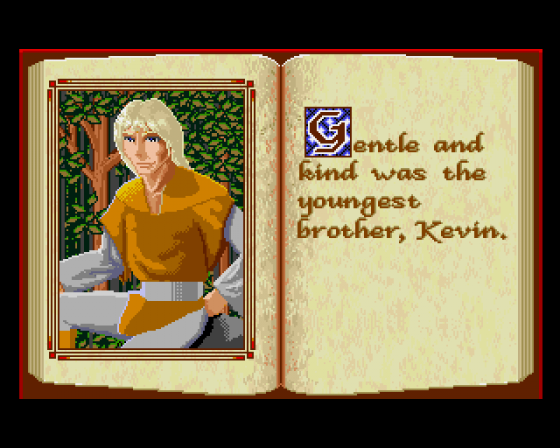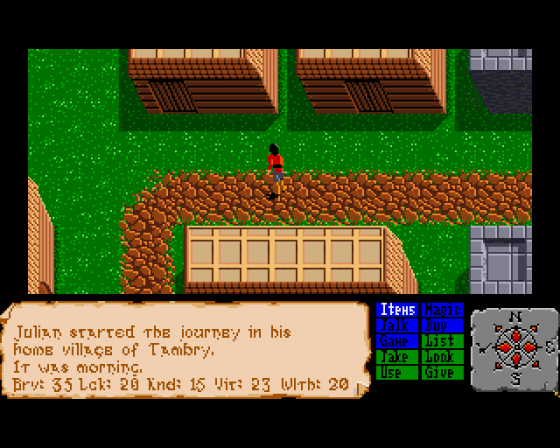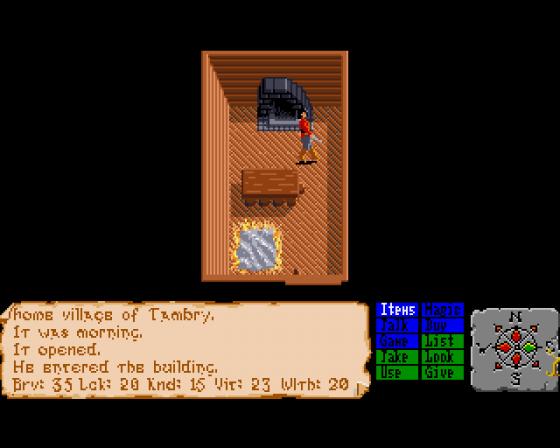
C&VG
 1st October 1987
1st October 1987
Categories: Review: Software
Publisher: Microillusions
Machine: Amiga 500
Published in Computer & Video Games #72
Faery Tale
As everybody knows, a reviewers lot is not a happy one. I mean, being paid to play games all day and then write about them is no-one's idea of fun - right?!
However, from time to time, a little cracket comes along, like a breath of fresh air, breathing new life into an industry much criticized for its lack of imagination and originality. Such a game is Faery Tale from Microillusions!
Faery Tale was written in California over six months by programmer, musician, and artist David Joiner, who has created a 17,000 screen magical land complete with underground caverns, mazes, forests, deserts, snow-capped mountains, lakes, castles, villages, and even the Astral World - so the packaging promises.

The name of Joiner's land is Holm, and you play the parts of three brothers in their quest to recover a carved Talisman, stolen from their village, Tambry.
The Talisman had been kept sacred by generations, by the villagers, who firmly believed it had the power to protect the village from all evil.
The theft of the Talisman followed a night of strange goings on which started with a dark, hooded, figure floating through the middle of the village. Not far behind this mysterious spectre, marched hordes of dead corpses and skeletons, all armed with swords and maces.

The ghastly procession halted in the centre of the village and the creatures began performing a hideous ritual which lasted until dawn. When the first villagers ventured out of their houses they discovered the Talisman was missing. And so your quest begins.
When the game is first loaded, you are treated to a graphically sensational picture book account of the story so far, complete with pages that turn, like some old Hollywood movie.
The game starts with Julian, the first of the brothers, standing outside a wooden hut in Tambry. You only get to play the second and third brothers if and when the first and second ones are killed off.

The top two thirds of the screen are a window looking down onto the immediate area around Julian. The bottom third of the screen is the status area, divided into three sections.
On the left, a scroll contains a commentary on the game together with your levels of bravery, luck, vitality, etc. These affect your performance during combat and can be improved by eating and gaining experience in much the same way as with many Dungeons & Dragons type games.
In the centre of the status area is the control box, with which you communicate with the game. Here you can instruct Julian to eat, sleep, use magic, or buy, give, pick up, and use any object being carried or within range. You can also talk to other characters in the game and 'look' around, which, when used in the right places, often reveals hidden objects of great importance or value.

The right hand section of the status area is a stone tablet, carved with the eight principle points of the compass. You can make Julian move in the required direction by simply clicking on the relevant part of the compass.
As Julian begins walking around the village, so the screen smoothly follows him, lagging slightly behind, so that, when he stops, the screen scroll continues for a second as it too, slows and gently stops - very neat!
Although the view is essentially plain, the hut where you first encounter Julian, as with all buildings is seen from a slight angle, allowing you to see both the south and east facing walls.

In this case, the south wall has a door which will automatically open if you move Julian towards it.
After a slight, any annoying, pause of about eight seconds for disk access, Julian enters the building where you are given a view "through the roof" onto the proceedings below (If you have the 'music' icon switched on, you will notice the music changes as you enter the building, and reverts to the 'outside' soundtrack when you go back outside.
Faery Tale, is full of neat touches like the day and night feature. With superb music and digitised sound effects, together with well designed graphics, plenty of characters to meet, both good and evil, and lots of objects to find and use, this first class animated adventure should keep adventure and arcade adventure freaks occupied for ages - highly recommended.
Other Reviews Of The Faery Tale Adventure For The Amiga 500
Faery Tale Adventure (Mediagenic/Microillusions)
A review
Faery Tale Adventure (Microillusions)
A review by Keith Campbell (Commodore User)
CU Update
A review






